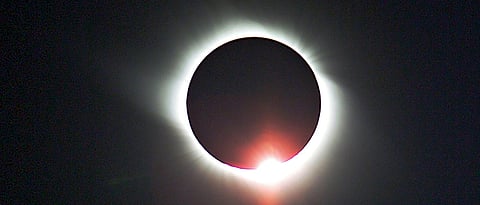

Pune: The significance of May 29, 2019 is that it was the day when exactly 100 years ago, Albert Einstein’s ‘General Theory of Relativity’, was tested and proved true for the first time with the help of a total solar eclipse and also established Einstein as a scientist.
This was the day in 1919 when solar eclipse observations successfully tested Einstein’s ‘General Theory of Relativity’.
Explaining the significance of the event to Sakal Times, renowned astrophysicist and Professor Emeritus at the Inter-University Centre for Astronomy and Astrophysics, (IUCAA) Ajit Kembhavi said, “In 1915, Einstein presented his Theory of Relativity and made three predictions. One was that the planets behind the Sun while passing through the Sun, bend light due to its gravity.”
Since we can see the Sun only during the day, we cannot see the planets behind it nor the light if any, they emit. Kembhavi said, “It is only during the total solar eclipse we can see this. To verify this, British astronomer Sir Arthur Eddington set out on an expedition to test the prediction that light would be deflected by the Sun.”
“Since the experiment involved viewing stars that are close to the Sun, it could only be done when there is total solar eclipse. The solar eclipse of May 29, 1919 presented the perfect opportunity to take the measurements. Thus, two expeditions were organised at two different locations from where the eclipse would be total. One place selected was Sobral (Brazil) and other one was at São Tomé and Príncipe off the coast of Africa,” said the press release by International Astronomical Union.
Sir Frank Watson Dyson coordinated the expeditions from England, dispatching Eddington to Príncipe and French astronomer Andrew Crommelin to Sobral. The results were compatible with Einstein’s theory.
At the same time, the results diverged significantly from Newtonian gravity.
Since then, the experiments have been carried out to test general relativity, which is widely used in modern physics and astrophysics.
Interestingly, a total solar esclipse will take place on July 2 this year, but it will not be visible from India. However, another solar eclipse will take place on December 26, which will be visible from India.
Celebrations held throughout the year
Eddington@Sundy: 100 Years Later is celebrating the 100th anniversary of the 1919 eclipse, promoting educational activities, conferences and other initiatives on a global scale.
The IAU100 Einstein Schools Global Project is creating a network of schools encouraging the understanding of the essential role of gravity in modern astronomy through exciting astronomical topics. These include gravitational waves, space-time, and the detection of gravitational waves emitted from compact objects such as black holes and neutron stars. Teachers in over 200 schools in 45 countries are already enrolled in the programme, and are working towards their school becoming an Einstein School. The project is now seeking astronomers who would like to volunteer as mentors for the schools in the programme.
LightSound is a tool developed for visually impaired and auditorily oriented to experience the variation of light intensity during a solar eclipse in real-time (through sound).
The Royal Astronomical Society has published a commemorative website including relevant information about the 1919 solar eclipse expeditions and information and educational resources about solar eclipses and general relativity.
